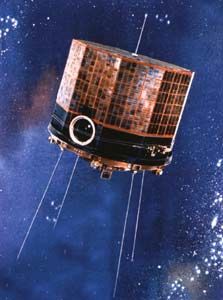
Home - Search - Browse - Alphabetic Index: 0- 1- 2- 3- 4- 5- 6- 7- 8- 9
A- B- C- D- E- F- G- H- I- J- K- L- M- N- O- P- Q- R- S- T- U- V- W- X- Y- Z
Program 35
 DMSP-Block-4A F3 Credit: Manufacturer Image |
Status: Operational 1962. First Launch: 1962-05-24. Last Launch: 1963-09-27. Number: 5 .
The first CORONA photos in August 1960 convinced authorities that knowledge of cloud cover over Russia was necessary and could be obtained only via satellite. Since the civilian TIROS program could not yet meet the requirement, the Director, National Reconnaissance Office (DNRO) authorized an interim program.
Launched by Blue-Scout boosters, the system would operate for one year until TIROS could take over. Program II began officially on 1 August 1961. Colonel Thomas Haig accepted the program director's position on three conditions: that he could use fixed-price, firm-schedule contracts; that he could select the personnel for his program office; and, that he did not have to use a civilian system engineering and technical direction (SE&TD) contractor. When TIROS delays persisted, Program II continued as Program 35. Confronted by problems of operating the meteorological satellites within the ground system designed for CORONA, Haig proposed two dedicated ground stations and a separate control center operated solely by Air Force personnel-no contractors. Ten months later the nation's first operational satellite program manned entirely by Air Force military personnel became a reality.
After the "Blue Scout" booster proved inadequate, Haig proposed refurbishing Thor intermediate-range ballistic missiles (IRBMs) and adding a second stage plus parts from other boosters to create a new launch vehicle. This led to the DMSP series of satellites. Haig and his "blue-suit" crew were deeply involved in engineering and development aspects of the program. They invented magnetic spin-rate control of the satellite, conceived and introduced innovations which greatly reduced the cost of ground stations, and developed simplified tracking software. The precedents established and attitudes generated in Haig's program office persisted long after the military meteorological satellite program was declassified and dubbed the Defense Meteorological Satellite Program (DMSP).
Family: Earth, Earth weathersat. Country: USA. Launch Vehicles: Scout, Scout X-2, Scout X-2M, Scout X-3, Scout X-3M, Scout X-2B. Projects: DMSP. Launch Sites: Vandenberg, Vandenberg SLC5. Bibliography: 126, 2, 569, 6, 6799.
1962 May 24 - . Launch Site: Vandenberg. Launch Complex: Vandenberg SLC5. LV Family: Scout. Launch Vehicle: Scout X-2M. FAILURE: Failure.. Failed Stage: U.
- P 35-1 - . Payload: FTV 3501. Nation: USA. Agency: USAF AFSC. Program: DMSP. Class: Earth. Type: Weather satellite. Spacecraft: Program 35. Decay Date: 1962-05-24 . Military weather satellite to provide targetting information for reconnaisance satellites..
1962 August 23 - . 11:44 GMT - . Launch Site: Vandenberg. Launch Complex: Vandenberg SLC5. LV Family: Scout. Launch Vehicle: Scout X-2M.
- P 35-2 - . Mass: 91 kg (200 lb). Nation: USA. Agency: USAF. Program: DMSP. Class: Earth. Type: Weather satellite. Spacecraft: Program 35. USAF Sat Cat: 369 . COSPAR: 1962-A-Omicron-1. Apogee: 752 km (467 mi). Perigee: 578 km (359 mi). Inclination: 98.50 deg. Period: 98.10 min. Military weather satellite to provide targetting information for reconnaisance satellites..
1963 February 19 - . 16:33 GMT - . Launch Site: Vandenberg. Launch Complex: Vandenberg SLC5. LV Family: Scout. Launch Vehicle: Scout X-3M.
- P 35-3 - . Mass: 40 kg (88 lb). Nation: USA. Agency: USAF. Program: DMSP. Class: Earth. Type: Weather satellite. Spacecraft: Program 35. Decay Date: 1979-12-26 . USAF Sat Cat: 533 . COSPAR: 1963-005A. Apogee: 810 km (500 mi). Perigee: 488 km (303 mi). Inclination: 100.50 deg. Period: 97.80 min. Military weather satellite to provide targetting information for reconnaisance satellites..
1963 April 26 - . Launch Site: Vandenberg. Launch Complex: Vandenberg SLC5. LV Family: Scout. Launch Vehicle: Scout X-2M. FAILURE: Failure.. Failed Stage: U.
- P 35-4 - . Payload: OPS 1298. Nation: USA. Agency: USAF. Program: DMSP. Class: Earth. Type: Weather satellite. Spacecraft: Program 35. Decay Date: 1963-04-26 . Military weather satellite to provide targetting information for reconnaisance satellites..
1963 September 27 - . 11:17 GMT - . Launch Site: Vandenberg. Launch Complex: Vandenberg SLC5. LV Family: Scout. Launch Vehicle: Scout X-2B. FAILURE: Failure.. Failed Stage: U.
- P 35-5 - . Payload: OPS 1610. Mass: 40 kg (88 lb). Nation: USA. Agency: USAF. Program: DMSP. Class: Earth. Type: Weather satellite. Spacecraft: Program 35. Decay Date: 1963-09-27 . Military weather satellite to provide targetting information for reconnaisance satellites..
Back to top of page
Home - Search - Browse - Alphabetic Index: 0- 1- 2- 3- 4- 5- 6- 7- 8- 9
A- B- C- D- E- F- G- H- I- J- K- L- M- N- O- P- Q- R- S- T- U- V- W- X- Y- Z
© 1997-2019 Mark Wade - Contact
© / Conditions for Use